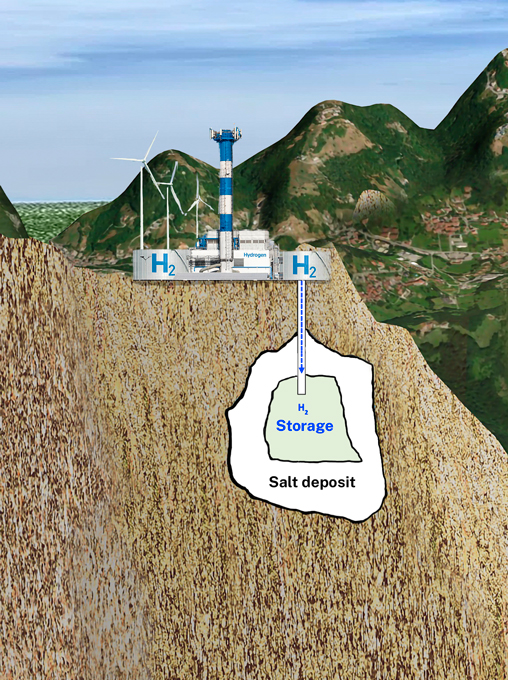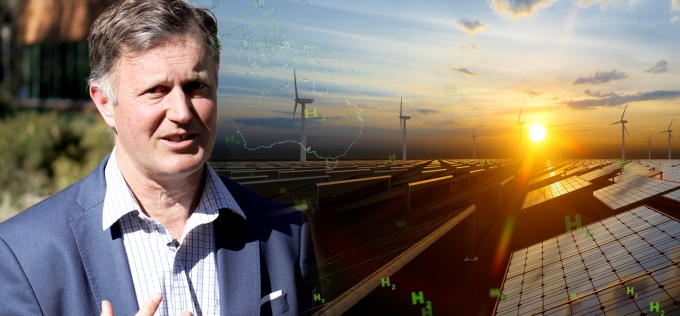Researchers at the Australian National University (ANU) School of Engineering, in partnership with the Heavy Industry Low-carbon Transition Cooperative Research Centre (HILT CRC), have unveiled an interactive web tool that calculates the cost of green hydrogen as a replacement for fossil fuels in heavy industry, and examines how the reliability of hydrogen supply impacts its cost.
At present, the industrial sector is responsible for 34 per cent of global carbon emissions.
Green hydrogen has the potential to be an important part of achieving Australia’s emissions reduction target of 43 per cent and net zero emissions by 2050. In particular, a focus on use of hydrogen for decarbonising existing export industries, and enabling new ones, is likely to bring strong emissions reduction benefit.
But with large capital investment requirements and little differentiation between products, industry leaders are reluctant to take the leap.
“There is a perception that, when you add the cost of storing hydrogen, it is not economical anymore,” said Dr Ahmad Mojiri. “The industry needs to have an understanding of the expected price and then see whether it is justifiable.”
“One of the most surprising findings from the study was that the cost of hydrogen doesn’t dramatically increase as you go up to 100 per cent capacity factor, as long as you have a fairly cheap form of energy storage,” said Dr Joe Coventry.
This means that it is possible to power heavy industry with green hydrogen continuously, day and night, throughout the year even during periods of cloud cover and/or low winds — a prerequisite for the green hydrogen transition.
From pollution plumes to harmless clouds of vapour
Along with harrowing footage of fires and floods, the visual tapestry for humanity’s climate catastrophe includes widescreen vistas of factories belching black smoke into the sky.
A green hydrogen transition would convert those pollution-filled plumes into harmless clouds of water vapour.
Green hydrogen is produced by using green electricity to power large electrolysers that split water into hydrogen and oxygen. The hydrogen is then fed directly into an industrial process, or stored for future use.
“The only by-product is water vapour created as the hydrogen combusts with oxygen,” Dr Mojiri said. “Other pollutants may arise when hydrogen is burned at very high temperatures, but this can be contained.”
HILT CRC’s partners in heavy industry are “genuinely interested in making this change, that is absolutely clear from talking to them”, Dr Coventry said.
“So, this is a concerted effort to look at the best way, the lowest cost way, the most sensible way of transitioning away from carbon usage in industry.”
“There is perceived pull from the market for greener products,” said Dr Mojiri. “That is probably the driving force here for these companies to decarbonise products that they have traditionally produced with a lot of emissions.”
Solar farms and wind farms are cheap to operate, but expensive to build. Energy prices are crucial to profitability, and the industrial sector’s unique requirement for voluminous and continuous energy supply means that the transition will require meticulous engineering.
The ratios between production of hydrogen, usage, and storage must be calculated with precision.
 The new study, titled “Green Hydrogen Supply Modelling for Industry”, was conducted in various locations across Australia where heavy industry operates, and where it makes sense to create regional hubs for future large-scale green hydrogen production plants.
The new study, titled “Green Hydrogen Supply Modelling for Industry”, was conducted in various locations across Australia where heavy industry operates, and where it makes sense to create regional hubs for future large-scale green hydrogen production plants.
“In regions where wind and solar are not available for extended periods of a year, storage is a very important component of the system,” Dr Mojiri said.
“The way the study works is we define a mathematical model that includes wind farms, solar farms, electrolysers, and hydrogen storage,” said Dr Coventry. “We use an optimisation technique to size each of these components in an optimal way. What pops out of the model is the lowest cost combination of size for each of these components for a given region.”
Engineering a clean energy future
The economic and engineering challenges of converting heavy industry to green hydrogen are much more varied and complex than achieving 100% grid electricity from renewable sources, which the Australian Capital Territory achieved in 2020.
In addition to using hydrogen as an energy carrier, heavy industry employs hydrogen as a feedstock — during hydrogen reduction, for instance, which adds hydrogen to iron ore, or when producing ammonia.
The chemical industry currently produces ammonia, which is crucial for the agriculture industry, using hydrogen made from natural gas, with CO as a by-product.
Also, one third of heavy industry’s energy demand is for high-temperature heat, which is difficult to achieve using electricity.
“We are talking about gigawatt scale electricity for these large industrial applications,” Dr Mojiri said. “If you want to draw this much electricity from the grid, the grid will have to transition into a new power generation and transport configuration. So, it’s not a simple thing.”
Industrial furnaces currently combust fossil fuels such as natural gas to reach temperatures as high as 1300°C. They are built to operate for as long as 50 years to economically balance capital investment. Retrofitting existing fossil fuel infrastructures with hydrogen burners will eliminate decades of carbon emissions.
“Industry wants to make the change, and they want to do it quickly, but they want to do it in a way that doesn’t involve starting from scratch,” Dr Coventry said.
“We think that the cost of green hydrogen is going to get to a point where there’s maybe a slight increase in cost, but that’s a premium that society will be prepared to pay to meet the climate challenges that we face.”
Balance of wind, solar, storage changes over time
The study found that the source of energy in the optimised hydrogen production system varies from location to location, and changes over time.
“In Tasmania, wind really dominates the energy supply mix for this purpose,” said Dr Coventry. “But even in some of the more sunny locations, for example, the northern part of Australia, wind at the moment has a really important role to play.”
In most regions, a mix of wind and solar is the lowest cost combination, but the ratio will change over time.
“We have projected the cost of producing hydrogen into future, 2030 and 2050,” Dr Mojiri said. “For many locations, the energy source for green hydrogen will transition from mainly wind to mainly solar, and that is because of a significant cost reduction that is expected in the PV [photovoltaic solar cell] industry.”
 The research shows that the cheapest way to store hydrogen is below ground.
The research shows that the cheapest way to store hydrogen is below ground.
There is a developing technology that pumps water into underground salt deposits to create cavities from which hydrogen does not leak. In regions where salt deposits are not present, lined rock underground storage may be the most affordable option.
“You can dig cavities under the ground and then seal them with a specifically engineered concrete and steel,” Dr Mojiri said.
The component sizing web tool is available online. Weather data is adjusted depending on which hub location is chosen. Cost and performance assumptions are auto-filled, but can be adjusted by the user. The user can also choose between salt caverns and lined rock underground storage before hitting the optimise button and downloading results.
More to explore
The team is now launching a follow-on study described as a deeper dive into local factors for specific locations around Australia.
The team will examine the whole-of-supply-chain costs at different scales, as well as different hydrogen production technologies, and opportunities for additional revenue streams such as hydrogen export. Geological data will help determine the most economical approach to bulk hydrogen storage.
Other variables and scenarios abound.
“Are there existing pipelines available to bring hydrogen from one location to another location, or one industry to another? What collection of different industries might we locate a hub?” Dr Coventry said.
“At times, might it be worth taking electricity from the grid for hydrogen production, for instance when there’s low-cost electricity during sunny periods?”
The work towards energy transition away from fossil fuels will continue in collaboration with industry leaders, engineers, chemists, economists, and policymakers all playing their parts, coordinated by HILT CRC which is funded by the Australian Governments Cooperative Research Centre Program.
“Government has a really important role to play in terms of policy setting to ensure that this transition is done quickly and justly. Everyone involved in this this project is genuinely committed to making this change happen,” Dr Coventry said.

